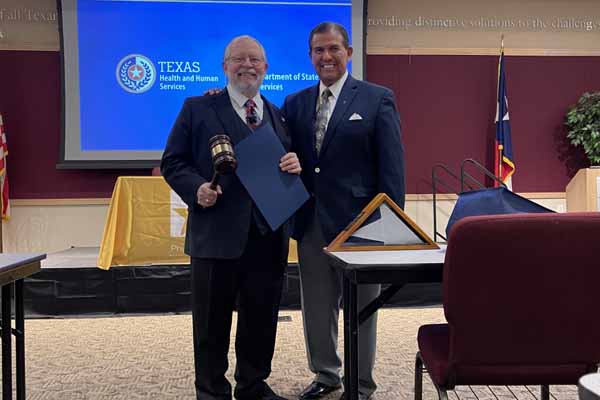
Nearly two and a half years after the first positive COVID-19 test result was reported in Texas, Department of State Health Services (DSHS) Commissioner John Hellerstedt, MD, is taking stock of what happened next and how to prevent the next pandemic.
And for his leadership in this response, Sen. State Sen. Eddie Lucio Jr. (D-Brownsville) honored Texas’ chief health official during “The State of Public Health in Texas,” an in-person and virtual event held in Austin on Aug. 11 by the Texas Medical Association, with the Texas Public Health Coalition, as part of TMA’s ongoing Distinguished Speaker Series. Video recordings are available on YouTube and Facebook.
“Leadership is not the ability to tell people what to do,” Senator Lucio said, presenting Dr. Hellerstedt with a Texas flag and a gavel on behalf of the Texas Senate. “Leadership is the ability to make people want to do the right thing by example. And [Dr. Hellerstedt] is an incredible, wonderful example of a leader in charge of health services for the great state of Texas.”
Despite the significant loss of life and financial consequences of the ongoing pandemic, Dr. Hellerstedt said during his presentation that Texas successfully threaded the needle in its response, avoiding an outright catastrophe and instead containing the damage at the level of a “big disaster.”
“Where we find ourselves today, where our society is intact and we’re ready to go forward and prosper, that outcome was in no way preordained,” he told an audience that included state lawmakers, their staff, and other stakeholders.
Dr. Hellerstedt highlighted DSHS’ efforts to expand hospital capacity during surge periods, when COVID-19 hospitalizations increased. At the height of the pandemic, Texas had recruited nearly 14,000 health care professionals from outside the state to ensure hospital beds were available and to bolster the existing workforce.
“We did not want to run out of hospital space,” he said, adding that some other states were forced to send critically ill COVID-19 patients to facilities many states away. “If we had, … that would have been one of the deepest breaches in the social contract that we could have.”
Dr. Hellerstedt also discussed the lessons learned over the course of the pandemic and the perils of “blindsight,” that is, not recognizing all the good work that has brought Texas to where it is today.
“The fact that we are where we are today is a tribute to the fact that enough people did enough of the right thing at the right time,” he said.
As Texas moves forward, Dr. Hellerstedt emphasized the importance of public health infrastructure, crisis communications, and combating vaccine hesitancy – all of which play a role in preventing the next pandemic and in responding to other infectious diseases, including congenital syphilis, hepatitis C, HIV, and monkeypox.
Texas’ outdated, underfunded public health infrastructure hampered its pandemic response, he said. Early in the pandemic, for example, the state struggled to meet surging demand for personal protective equipment and data reporting. The shortfall also exacerbated existing health disparities, especially among racial and ethnic minority groups.
Although federal funding has helped DSHS improve the state’s emergency preparedness, Dr. Hellerstedt cautions that this cash flow will eventually dry up – unless state lawmakers choose to invest in preventive measures.
DSHS’ priority “going forward is to be able to demonstrate to our leadership and to the public the genuine value that public health brings to the state,” he said.
The first months of the pandemic also offered a crash course in crisis communications. At that time, Dr. Hellerstedt and Gov. Greg Abbott participated in regular press conferences, where Dr. Hellerstedt offered guidance to Texans about how they could avoid COVID-19 and Governor Abbott announced new policies.
Dr. Hellerstedt said this type of partnership – between a public health advisor and an elected official – is crucial for effective crisis communications during public health emergencies.
“If you don’t have that, it’s not that the door is ajar. It’s that the door has sprung open, and what rushes in is misinformation and disinformation and confusion,” he cautioned.
Misinformation fueled skepticism about the COVID-19 vaccines, and Texas physicians say that skepticism has since spilled over onto all vaccines. Acknowledging this challenge, Dr. Hellerstedt stressed the importance of physicians’ role in addressing it, since they have developed their patients’ trust and may be able to dispel their hesitancy.
“I’m here to tell you public health can’t do it by itself,” he said.